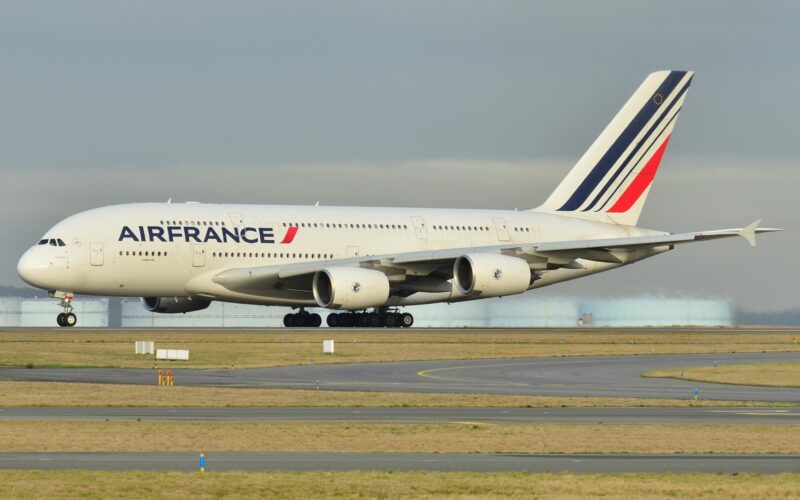Updated on August 23, 2019, to include a statement from the EASA
Investigation into a mid-air engine explosion on an Air France Airbus A380 in 2017 has reportedly brought to light some troubling findings that might prompt the plane maker to declare urgent checks on some of its superjumbos. A report by Reuters indicates that France’s BEA air accident investigation agency has identified a possible manufacturing flaw in a recently recovered part of one of the aircraft’s engines that abruptly disintegrated in-flight and disappeared in an ice sheet in Greenland.
Late in June 2019, after a two year-long inter-organization search mission aided by advanced technologies, researchers of the Geological Survey of Denmark and Greenland (GEUS) finally recovered the missing fan hub of an Air France’s Airbus A380 (registered F-HPJE) engine that suffered what is known as an uncontained engine failure over Greenland in September 2017.
Following a subsequent investigation, the French Bureau of Enquiry and Analysis (BEA) reportedly discovered a “sub-surface fatigue crack” in the salvaged part of the Engine Alliance GP7200 power plant, indicating a possible manufacturing flaw by the engine maker, Reuters reported on August 21, 2019.
According to sources familiar with the matter, cited by the news agency, the manufacturer is currently preparing urgent inspections on the GP7200 engines. It is not known at the moment what sort of inspections would be performed and whether they would require grounding in-service aircraft fitted with these engines.
The GP7200 is built by U.S.-based Engine Alliance, a consortium of General Electric and Pratt & Whitney, exclusively for the Airbus A380. Another engine type currently offered to power the Airbus A380 is Rolls-Royce Trent 900 series. Sources, however, told Reuters the engine part in question was manufactured by Pratt & Whitney.
Airbus declined to respond to AeroTime’s enquiry, stating only that the company cannot comment on an ongoing investigation. However, if inspections were indeed to be ordered, it would possibly affect dozens of superjumbo jets. According to Airbus’ latest figures (as of July 31, 2019), there are 237 A380s currently in-service with 15 operators worldwide. According to Reuters estimates, the GP7200 engines power a total of 152 of the 237 A380s in operation.
A spokesperson for the European Union Aviation Safety Agency (EASA) has confirmed to AeroTime on August 23, 2019, that “repeated inspections” will indeed be necessary: “Following the recent examination of retrieved engine parts, mandatory actions have been agreed between all involved parties which will call for repeated inspections of the affected engine type (GP7200).”
“An Airworthiness Directive to this effect is expected to be issued within the next two weeks,” the spokesperson said in a statement, adding that the BEA’s investigation in this case is being conducted in close coordination with experts from both EASA and FAA.
Another, separate, issue was recently detected on some of A380s, prompting the EU safety athority to issue a proposed Airworthiness Directive (EASA AD 19-116) on July 5, 2019. The directive called on Airbus to inspect some of its early production superjumbos for cracks in the affected areas of the wing ORS [Outer Rear Spar]. The proposed AD applied to 25 A380s currently in service with airlines around the world.
Lost and found
On September 30, 2017, the Air France A380 flight AF066 was en route from Paris Charles de Gaulle Airport (CDG) to Los Angeles International Airport (LAX), carrying 497 passengers and 24 crew members on board.
About five hours into the flight, during cruise over Greenland, a fan and inlet separated from the engine number four. The aircraft was diverted and landed safely at the Canadian Forces Goose Bay (YYR) base two hours later. No injuries were reported.
Since Greenland is an autonomous territory of Denmark, it was the Danish Accident Investigation Bureau (AIB DK) that delegated the investigation to BEA. So began a two year-long search operation to locate and retrieve the detached fan hub.
According to a technical report by the BEA: “A visual check of the engine had shown that the fan, first rotating assembly at the front of the engine, along with the air inlet and fan case, had separated in flight”.
“Quite early in the investigation, it was established that the recovery of the missing parts, especially of the fan hub fragments, was the key to supporting the investigation of the cause of the engine failure,” the report states further.
While some torn-away pieces were retrieved on the runway, most of them, including the fan, fell over Greenland, on ice-covered terrain and typical of extreme weather conditions that hampered the search mission.
Using high-tech aerial radar search, GEUS researchers managed to zero-in on the possible location of the crucial missing part of the engine, which was finally detected by a radar-equipped robot. The 3-meter (9.84 feet) wide fan hub, weighing 150 kilograms (330 pounds), was extracted from the ground under a thick sheet of ice and snow on June 30, 2019.

The recovered fan hub of the GP7200 (Credit: Dirk van As, Greenland Guidance)

